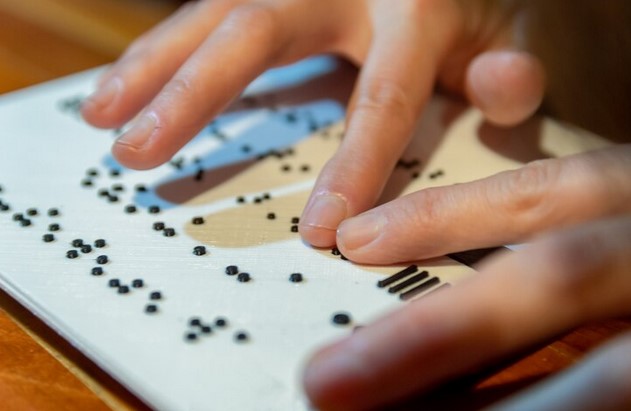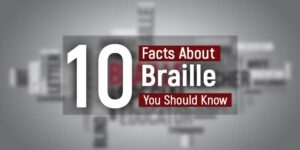Braille is the most popular tactical reading and writing system across the globe. Crafted by the ingenious mind of Louis Braille, it is an arrangement of raised dots to words, letters, and punctuations.
For those who are visually impaired, Braille represents so much more than a mere system of raised dots. It is a lifeline, a gateway to literacy, and a key that unlocks a world of opportunities.
Through the intricate patterns of dots, Braille allows individuals to access information, to braille music, express themselves, and participate fully in society, irrespective of their visual limitations.
Yet, the enchanting tale of Braille extends far beyond these mere glimpses, captivating us with its hidden facts.
Check out these 10 facts about Braille that you might have not known.
- Braille: More than Just a Language:
Contrary to popular belief, Braille is not a language itself. Instead, it is a system of raised dots that represent letters and numbers, enabling blind and visually impaired individuals to read and write in various languages with the help of braille transcription services. This groundbreaking invention by Louis Braille in the early 19th century transformed the lives of countless individuals with visual impairments.
- Braille’s Military Origins:
Unbeknownst to many, Braille’s roots lie in its use as a military code. Inspired by a night-time conversation with a French army captain, Charles Barbier, young Louis Braille developed a simplified tactile code known as “Ecriture Nocturne” (night writing). Originally intended to facilitate silent communication for soldiers, Braille eventually refined the system into the powerful literacy tool we know today.
- The Space Challenge:
One of the intriguing aspects of Braille is that it requires more space than traditional alphabets. Composed of raised dots, each character occupies a specific configuration of six dots, arranged in two columns of three.
This unique structure necessitates more room, resulting in Braille text occupying a larger physical area compared to standard printed text. However, the benefits it offers in terms of accessibility and independence far outweigh this spatial drawback.
- Braille Music: A Harmonious Language:
In addition to facilitating language and literary expression, Braille has also opened the doors to musical notation. Developed by Louis Braille himself, Braile music notation allows blind and visually impaired musicians to read and perform compositions with remarkable accuracy.
By assigning specific Braille symbols to musical notes, dynamics, and other musical elements or Braille piano, this unique system empowers musicians to engage with the beauty of sound.
- Braille Olympics:
Empowering the Visually Impaired: Did you know that there is an international sporting event dedicated exclusively to individuals who are blind or visually impaired?
The Braille Olympics, also known as the Braille Challenge, celebrates the achievements and abilities of Braille users across the globe. Participants compete in a range of events, including spelling, reading comprehension, and speed typing, showcasing their mastery of this invaluable tactile language.
- The Braille Embosser: Giving Shape to Words:
In the realm of assistive technology, the Braille embosser stands as a remarkable invention. This machine, connected to a computer, converts digital text into Braille by embossing the raised dots onto specialized paper.
With the ability to produce Braille music or any other documents at an impressive speed, embossers have become indispensable tools in schools, libraries, and offices, fostering accessibility and promoting inclusivity for individuals with visual impairments.
- Contracted vs. Uncontracted Braille:
Braille encompasses two distinct forms: contracted and uncontracted. Uncontracted Braille, also known as Grade 1, represents each letter of a word with a corresponding Braille character.
This form is often used by beginners or when precision is required, such as in legal or scientific documents. Contracted Braille, or Grade 2, employs a series of shorthand symbols, abbreviations, and contractions, allowing for faster reading and reduced space usage.
- The ATM Connection:
Next time you use a drive-through ATM, take a closer look at the keypad buttons. You’ll notice that the numbers are not only printed but also accompanied by Braille symbols.
This thoughtful inclusion stems from the fundamental principles of accessibility and equal rights, ensuring that individuals with visual impairments can access financial services independently and confidentially.
- Braille’s Enduring Legacy:
More than two centuries after its creation, Braille remains a vital tool for promoting literacy, independence, and inclusivity for the visually impaired.
Its impact extends far beyond reading, empowering individuals to pursue education, employment, and many more things. Through ongoing advancements in technology and education, Braille remains an essential element in fostering an inclusive society.
- The Universal Braille Code:
Braille has surpassed language barriers by adopting the Universal Braille Code (UBC). This code allows individuals to transcribe various writing systems, including mathematical notations, and even computer code, into Braille. Through this code, Braille has become a truly global system, enabling the exchange of information across cultures and disciplines.
Conclusion:
Braille has forever transformed the lives of millions of people, opening gateways to literacy and so much more.
Through Braille music notation, individuals who are blind can explore the enchanting melodies, harmonies, and rhythms that enrich our lives.
From Braille sheet music to the remarkable Braille piano, this tactile language ignites the passion and creativity of musicians, allowing them to communicate and share their musical artistry with the world.
Get Professional Braille Transcription Services from us. Empower the visually impaired with our accurate and reliable Braille transcription. Contact us now for a seamless accessibility experience.







